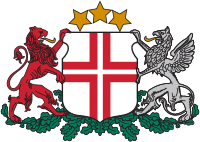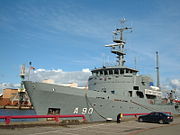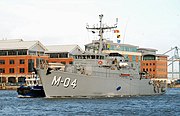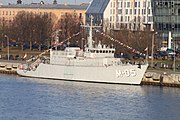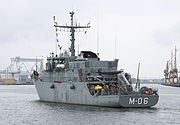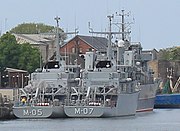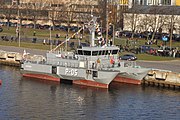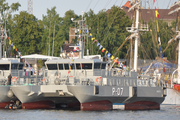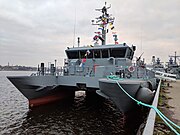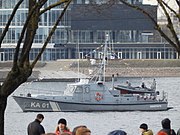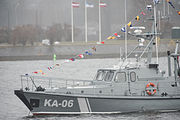|
Latvian Naval Forces
Latvian Naval Forces (Latvian: Latvijas Jūras spēki) is the naval warfare branch of the National Armed Forces. It is tasked with conducting military, search and rescue operations, mine and explosive sweeping on the Baltic Sea, as well as ecological monitoring activities. The Naval Forces have participated in international NATO/Partnership for Peace operations and various exercises with great success. The main development priorities of the Naval Forces are to expand their activities within the Baltic States’ Ship Squadron BALTRON and to develop a Sea Surveillance System. They pay a great deal of attention to professionally specialized training and English-language teaching. HistoryIndependence to World War II The Latvian Naval Forces were founded on 10 August 1919 with its first ship being the former Imperial German minesweeper SMS M68. Previously, M68 had been sunk by a mine off Riga on October 29 1917. She was raised in 1918 and taken back to Riga for repairs, but was later seized by forces of the Latvian Socialist Soviet Republic in 1919, before being recaptured by Germany. Upon the conclusion of the Latvian War of Independence, and the victory of the Latvian Provisional Government, M68 was formally commissioned into the Latvian Naval Forces as Virsaitis. She would remain the Latvian Navy's only warship until 1926. In 1926, two new Viesturs-class minesweepers, Viesturs and Imanta were ordered from France and commissioned later that year. The same year, two Ronis-class submarines; Ronis and Spīdola, also ordered from France, were commissioned. A sixth vessel, the former German icebreaker Passat became the submarine tender Varonis. The six ships consisted of the entirety of the Latvian Naval Forces during its first incarnation, as The Great Depression hindered further expansion. The Navy saw no action during its early existence. In August 1940, the Soviet Union invaded and occupied Latvia, and thus, seized all six Latvian warships. All were incorporated into the Baltic Fleet. Both submarines retained their names, but Virsaitis was renamed T-297 (her name was restored the following year), Viesturs was renamed T-298, Imanta was renamed T-299, and Varonis was renamed Ural. All six ships served in World War II in various roles. Ronis and Spīdola were scuttled in Liepāja on June 24 1941 to prevent their capture by German forces. T-299 struck a mine and sank off Saaremaa on July 1 1941. Ural struck a mine and sank on 28 August 1941. Virsaitis took part in the evacuation of the Soviet garrison on the Hanko Peninsula in late 1941. On December 2 1941, she struck a mine and sank off Hanko. T-298 was the only former Latvian warship to survive World War II and was later converted to a survey ship in 1948. Her final fate is unknown. Post-1991 When Latvia regained its independence in 1991, it began recreating the Latvian Naval Forces under the command of Admiral (then Captain) Gaidis Zeibots. In 1994 the Naval Forces were composed of the Southern Region (in Liepāja), the Central Region (in Riga), the Coastal Defense Battalion (in Ventspils) and the Training Center (in Liepāja). The most important naval event of these early days of the re-established Latvian Republic occurred on 11 April 1991 when the Latvian flag was hoisted on the re-established Navy's first ship "SAMS". This date is now recognized as the rebirth of the Latvian Naval Forces. In 1999 the Baltic Naval Squadron (BALTRON) was created with ships from the Lithuanian, Latvian and Estonian Navies. Latvian Navy Captain Ilmars Lesinskis, then the Commander of the Southern District, was appointed to serve as the first commander of this multi-national force. On 1 July 1999 Latvian Naval Forces were reorganized. The present structure was established on the basis of previous regional units – the War Ships Flotilla (HQ is in Liepāja), the Coast Guard Ships Flotilla in Riga (subunits are in Liepāja and Ventspils), the Coastal Defense Battalion in Ventspils (subunits are along the coast of the Baltic Sea and Riga Bay), the Training Center in Liepāja, the Logistic Base in Liepāja (subunits are in Riga and Ventspils). On 1 July 2004 Latvian Naval Forces were reorganized again and since that time they consist of the Naval Forces Headquarters, Naval Forces Flotilla HQ with subunits and the Coast Guard Service. The new structure organizes personnel training and specialization better than before, as well as shares greater responsibility between commanders. As part of the program to equip the Naval Forces with modern assets, the first of a new generation of nationally made patrol vessels, made with German assistance, was launched in 2011. Mission The Naval Force provides defense of the national territorial waters, carries out explosive ordnance disposal activities at sea and harbors, co-ordinates and carries out human search and rescue operations at sea within the national responsibility area. Warships of the Republic of Latvia have repeatedly made visits to foreign countries and have supported the visits of foreign warships and naval representatives in Latvia. The warships of the Latvian Naval Forces Southern Region have participated in numerous international exercises (U.S. BALTOPS, COOPERATIVE JAGUAR, AMBER SEA, OPEN SPIRIT, etc.). These exercises have been conducted to NATO standards, which Latvian ships have successfully met. The main tasks of Naval Forces are to:
Structure of the Naval Forces
Ships in the Naval ForcesCurrent
Retired
Ranks and insignia
See alsoReferences
External linksWikimedia Commons has media related to Navy of Latvia. |
|||||||||||||||||||||||||||||||||||||||||||||||||||||||||||||||||||||||||||||||||||||||||||||||||||||||||||||||||||||||||||||||||||||||||||||||||||||||||||||||||||||||||||||||||||||||||||||||||||||||||||||||||||||||||||||||||||||||||||||||||||||||||||||||||||||||||||||||||||||||||||||||||||||||||||||||||||||||||||||||||||||||||||||||||||||||||||||||||||||||||||||||||||||||||||||||||||||||||||||||||||||||||||||||||||||||||||||||||||||||||||||||||||||||||||||||||||||||||||||||||||||||||||||||||||||||||||||||||||||||||||||||||||||||||||||||||||||||||||||||||||||||||||||||||||||||||||||||||||||||||||||||||||||||||||||||||||||||||||
